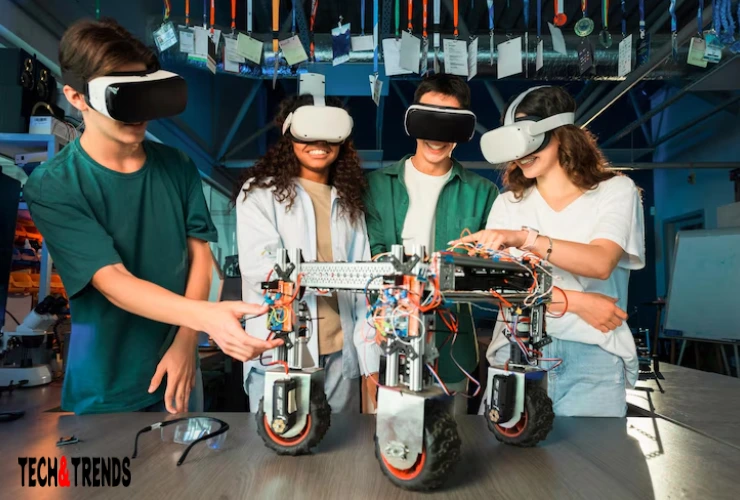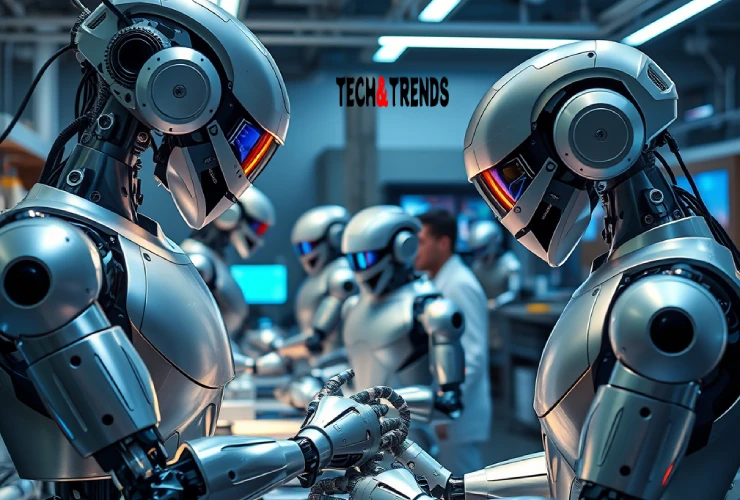Robots have come a long way from being simple machines that follow a set of instructions. Today, robots are smart, flexible, and able to do things that were once only possible for humans. With new technology, robots are changing how we live and work. In this article, we will look at the latest cool inventions using technology, especially in the world of robots and what the next generation of robots will be like.
What Are Robots?
Robots are machines that can move and do tasks on their own or with a little help from humans. Some robots look like people, while others look like animals or are just machines with arms and wheels. Robots are used in many places, such as factories, hospitals, schools, and even at home.
Why Are Robots Important?
Robots help people by doing jobs that are boring, dangerous, or too hard for humans. For example, robots can work in factories, clean floors, help doctors in surgery, or even explore space. Robots can also help people with disabilities and make our lives easier.
Cool Inventions Using Technology: Robots in 2025
In 2025, robots are more advanced than ever before. They use new technology like artificial intelligence (AI), machine learning, and sensors to understand the world around them. Here are some of the coolest inventions using technology in robotics this year.
1. Humanoid Robots That Learn
Humanoid robots are robots that look and move like people. In 2025, humanoid robots can learn from their experiences, just like humans do. For example, robots like Figure02 and Atlas can do things like putting away groceries, sorting packages, and even dancing or doing cartwheels. These robots use AI to learn new tasks and get better over time.
2. Robots That Work Together
Some robots can now work together as a team. For example, two Figure02 robots can help each other put away groceries or sort packages in a factory. These robots can share information and learn from each other, making them smarter and more efficient.
3. Robots With Super Senses
New robots have sensors that help them see, hear, and feel things. These sensors let robots understand their environment and react to changes. For example, robots can now pick up objects they have never seen before and figure out where to put them.
4. Robots That Help at Home
Companies are testing robots in real homes. Robots like Neo Gamma are being tested in hundreds of homes to help with chores, learn from people, and get better at their jobs. These robots can be controlled by people from far away, but soon, they will be able to work on their own.
5. Robots in Factories
Robots are already used in factories, but now they are even smarter. They can do complex tasks like sorting thousands of different parts, fixing mistakes, and learning new things without human help. This makes factories safer, faster, and more efficient.
6. Robots for Disaster Response
Some robots are designed to help in emergencies. For example, the Unitree G1 robot can walk and run smoothly, do kung fu moves, and even perform a standing side flip. These skills make them useful for search and rescue missions in dangerous places.
7. Robots for Entertainment
Robots are not just for work—they can also be fun! Some robots can dance, play games, and even do tricks. These robots are used in shows, movies, and theme parks to entertain people.
8. Robots That Are Easy to Use
Collaborative robots, or “cobots,” are robots that work with people. They are easy to program and safe to use, even for people who are not experts in robotics. This means more businesses can use robots to help with their work.
9. Robots That Are Affordable
As technology gets better, robots are becoming cheaper. For example, Tesla’s Optimus robot is expected to cost around $20,000, making it affordable for many people and businesses. This means more people can use robots to make their lives easier.
10. Robots for the Future
The next generation of robots will be even smarter and more helpful. They will be able to learn from experience, work in teams, and do more tasks on their own. Robots will be used in more places, from homes and schools to hospitals and space.
Read more info ; Innovative Technology For Learning:
How Do Robots Work?
Robots use a combination of hardware and software to do their jobs. The hardware is the physical parts of the robot, like arms, legs, wheels, and sensors. The software is the “brain” of the robot, which tells it what to do.
Artificial Intelligence (AI) and Machine Learning
AI is a type of computer technology that lets robots think and learn. Machine learning is a part of AI that helps robots learn from data and improve their performance. With AI and machine learning, robots can understand their environment, make decisions, and solve problems.
Sensors
Sensors are devices that help robots see, hear, and feel. For example, cameras let robots see objects, microphones let them hear sounds, and touch sensors let them feel things. These sensors help robots understand the world around them and react to changes.
Connectivity
Robots can connect to the internet and other devices. This lets them share information, get updates, and work together with other robots or people.
Benefits of Robots
Robots have many benefits for people and businesses. Here are some of the main ones:
- Safety: Robots can do dangerous jobs, like working in mines or fighting fires, so people do not have to risk their lives.
- Efficiency: Robots can work faster and more accurately than humans, which helps businesses save time and money.
- Convenience: Robots can help with chores at home, like cleaning or cooking, making life easier for people.
- Accessibility: Robots can help people with disabilities by doing tasks that are hard for them.
- Learning: Robots can learn new skills and get better over time, which means they can do more things as they gain experience.
Challenges for Robots
While robots are very helpful, there are also some challenges:
- Cost: Some robots are still expensive, but prices are going down.
- Safety: Robots need to be safe to use around people, especially in homes and schools.
- Privacy: Robots with cameras and microphones need to protect people’s privacy.
- Jobs: Some people worry that robots will take away jobs, but robots can also create new jobs in technology and maintenance.
The Future of Robots
The future of robots is very exciting. In the next few years, we will see even more cool inventions using technology in robotics. Here are some things to expect:
- More Human-like Robots: Robots will look and act more like humans, making it easier for people to work with them.
- Better AI: Robots will get smarter and be able to learn more quickly.
- More Uses: Robots will be used in more places, like schools, hospitals, and even space.
- Teamwork: Robots will work together in teams, sharing information and helping each other.
- Affordability: Robots will become cheaper, so more people and businesses can use them.
Examples of Cool Robots in 2025
| Robot Name | What It Does | Why It’s Cool |
|---|---|---|
| Figure02 | Helps at home and in factories | Learns, works with other robots |
| Atlas (Boston Dynamics) | Does tricks, works in factories | Moves like a human, learns fast |
| Neo Gamma | Helps at home, learns from people | Controlled remotely, gets smarter |
| Unitree G1 | Walks, runs, does kung fu, helps in emergencies | Very agile, learns new moves |
| Tesla Optimus | Does chores, works in factories | Affordable, learns new tasks |
How Robots Are Changing Industries
Robots are changing many industries, including:
- Manufacturing: Robots help build cars, electronics, and other products faster and more accurately.
- Healthcare: Robots help doctors with surgery, deliver medicine, and take care of patients.
- Agriculture: Robots help farmers plant, water, and harvest crops.
- Construction: Robots help build houses and other buildings.
- Retail: Robots help in stores by stocking shelves and helping customers.
How to Get Involved with Robots
If you are interested in robots, there are many ways to get involved:
- Learn About Robotics: You can take classes or watch videos about robots and how they work.
- Join Robotics Clubs: Many schools and communities have robotics clubs where you can build and program robots.
- Study STEM: Science, technology, engineering, and math (STEM) are important for working with robots.
- Follow the News: Keep up with the latest cool inventions using technology in robotics.
Conclusion
Robots are some of the coolest inventions using technology today. In 2025, robots are smarter, more helpful, and more affordable than ever before. The next generation of robots will be even more amazing, helping people in new ways and making the world a better place. Whether you want to learn about robots, work with them, or just enjoy their benefits, the future of robotics is full of exciting possibilities.

